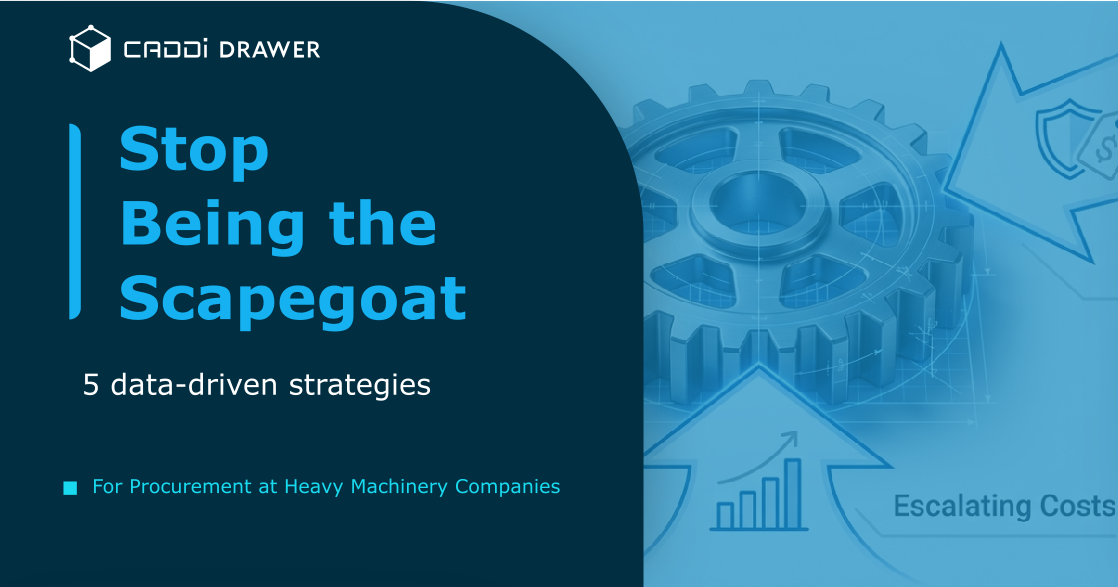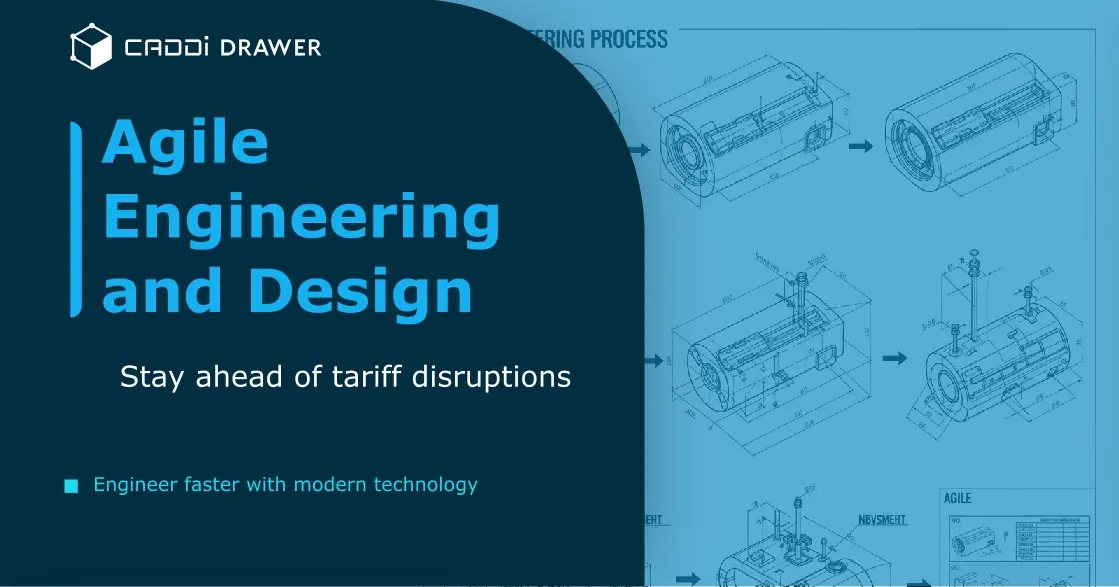Searchable Manufacturing Data - What is it and why is it helpful?

Table of Contents

Searchable manufacturing data refers to organizing and structuring the data your shop produces to be more helpful. This may sound trivial, but most data your shop produces is not usable in the form in which it’s produced.
Turning your data into a searchable asset is an essential part of digital transformation and is necessary to take advantage of many cutting-edge technologies.
Let’s break down some strategies for making your data more searchable, and what benefits you can expect from investing in this process.
Digitizing your data
The first necessary step in making your data searchable is making it digital. A lot of your old manufacturing data, including drawings, logs, and orders, may still be stuck on paper. Despite this data being old, it may still offer crucial insights for future decisions. Scanning these documents is a worthy investment of time.
Another important type of digitization needs to occur in your production line. Your machines should be automatically logging data that they produce in operation. This can include their current settings, output rate, and, depending on the sophistication of your sensors, things like defect rate too. Make sure this data is captured in a central, analyzable location.
Extracting trapped data into searchable fields
A lot of data you produce is “trapped” inside of files. For example, a scanned drawing has a lot of text on it in labels and the title block. When you open the scanned image file, you can read it. But when you search through your file system, you can’t search for text within the image.
Other examples of this sort of “trapped data” include:
- PDF documents – you can search through them when you have them open, but you can’t usually search for terms across all of your PDFs
- Spreadsheets – again, you can typically search while you’re inside of these, but you need to know which one to open
- 3D models and CAD drawings – usually require to be individually opened in a specific program to analyze
- Other proprietary data types – many files can only be opened and searched in specific programs, making them inaccessible for broader searches
Creating truly searchable manufacturing data involves extracting all of this text and structuring it to make it searchable. For text within images, this involves using optical character recognition (OCR) to extract text from the image. For other data, it involves creating a data lake that can take in data from all sorts of sources. Then, you can do one global search in the data lake to get all the context you need about any question.
Creating insightful connections across data
A major part of creating searchable manufacturing data is understanding what sort of questions people will want answered. Then, you need to structure your data to make those questions searchable. This often requires creating new types of contexts and connections.
For example, let’s say you want to understand inefficiencies in your production processes. You can probably identify which machines take longer than others. However, what you really want is to understand which machines are relatively slow given the type of work they’re doing. But how do you classify the type of work? It may seem to require tedious manual comparing and sorting. However, cutting-edge machine learning technology can create these categories for you automatically.
Here’s another example – one that we specialize in. Let’s say you want to save money on procuring component parts. You want to figure out where you can get better deals on certain types of parts. It may seem like you have to manually look at past order data and compare which parts are similar. But this is one of CADDi’s specialties. Just by doing a similarity search with one drawing, you can find order data for all parts with similar designs. Then you can more easily figure out which suppliers are offering the best deals for each type of part.
The benefits of searchable manufacturing data
So why make this investment into turning your manufacturing data into a searchable asset? There’s a plethora of reasons, but let’s highlight a few:
- Massive time savings on your workflows: nearly every person, on nearly every day, will need to search some previous data to make a new decision. Without searchable data, this can take hours, even days. If it takes too long, people will skip searching and make costly, time-consuming, and suboptimal decisions.
- Discovered cost savings: with well connected searchable data, finding cost savings changes from a lengthy process to something you can investigate on a whim. You can undertake exercises to consolidate suppliers and renegotiate deals with only a few searches.
- Reduced operational costs: many of your operational costs result from an excess of redundant parts, production issues accumulating without your notice, and other problems resulting from insufficient issues.
Making your manufacturing data searchable with CADDi
CADDi is a revolutionary tool in making your manufacturing data searchable. We create a data lake by collecting information across your PLM, PDM, ERP, CAD, and other tools. Then we use our amazing AI tech to connect data using intuitive qualities.
See it all in action by signing up for demo today.
Searchable manufacturing data refers to organizing and structuring the data your shop produces to be more helpful. This may sound trivial, but most data your shop produces is not usable in the form in which it’s produced.
Turning your data into a searchable asset is an essential part of digital transformation and is necessary to take advantage of many cutting-edge technologies.
Let’s break down some strategies for making your data more searchable, and what benefits you can expect from investing in this process.
Digitizing your data
The first necessary step in making your data searchable is making it digital. A lot of your old manufacturing data, including drawings, logs, and orders, may still be stuck on paper. Despite this data being old, it may still offer crucial insights for future decisions. Scanning these documents is a worthy investment of time.
Another important type of digitization needs to occur in your production line. Your machines should be automatically logging data that they produce in operation. This can include their current settings, output rate, and, depending on the sophistication of your sensors, things like defect rate too. Make sure this data is captured in a central, analyzable location.
Extracting trapped data into searchable fields
A lot of data you produce is “trapped” inside of files. For example, a scanned drawing has a lot of text on it in labels and the title block. When you open the scanned image file, you can read it. But when you search through your file system, you can’t search for text within the image.
Other examples of this sort of “trapped data” include:
- PDF documents – you can search through them when you have them open, but you can’t usually search for terms across all of your PDFs
- Spreadsheets – again, you can typically search while you’re inside of these, but you need to know which one to open
- 3D models and CAD drawings – usually require to be individually opened in a specific program to analyze
- Other proprietary data types – many files can only be opened and searched in specific programs, making them inaccessible for broader searches
Creating truly searchable manufacturing data involves extracting all of this text and structuring it to make it searchable. For text within images, this involves using optical character recognition (OCR) to extract text from the image. For other data, it involves creating a data lake that can take in data from all sorts of sources. Then, you can do one global search in the data lake to get all the context you need about any question.
Creating insightful connections across data
A major part of creating searchable manufacturing data is understanding what sort of questions people will want answered. Then, you need to structure your data to make those questions searchable. This often requires creating new types of contexts and connections.
For example, let’s say you want to understand inefficiencies in your production processes. You can probably identify which machines take longer than others. However, what you really want is to understand which machines are relatively slow given the type of work they’re doing. But how do you classify the type of work? It may seem to require tedious manual comparing and sorting. However, cutting-edge machine learning technology can create these categories for you automatically.
Here’s another example – one that we specialize in. Let’s say you want to save money on procuring component parts. You want to figure out where you can get better deals on certain types of parts. It may seem like you have to manually look at past order data and compare which parts are similar. But this is one of CADDi’s specialties. Just by doing a similarity search with one drawing, you can find order data for all parts with similar designs. Then you can more easily figure out which suppliers are offering the best deals for each type of part.
The benefits of searchable manufacturing data
So why make this investment into turning your manufacturing data into a searchable asset? There’s a plethora of reasons, but let’s highlight a few:
- Massive time savings on your workflows: nearly every person, on nearly every day, will need to search some previous data to make a new decision. Without searchable data, this can take hours, even days. If it takes too long, people will skip searching and make costly, time-consuming, and suboptimal decisions.
- Discovered cost savings: with well connected searchable data, finding cost savings changes from a lengthy process to something you can investigate on a whim. You can undertake exercises to consolidate suppliers and renegotiate deals with only a few searches.
- Reduced operational costs: many of your operational costs result from an excess of redundant parts, production issues accumulating without your notice, and other problems resulting from insufficient issues.
Making your manufacturing data searchable with CADDi
CADDi is a revolutionary tool in making your manufacturing data searchable. We create a data lake by collecting information across your PLM, PDM, ERP, CAD, and other tools. Then we use our amazing AI tech to connect data using intuitive qualities.
See it all in action by signing up for demo today.
.svg)



.svg)
.svg)
.svg)









